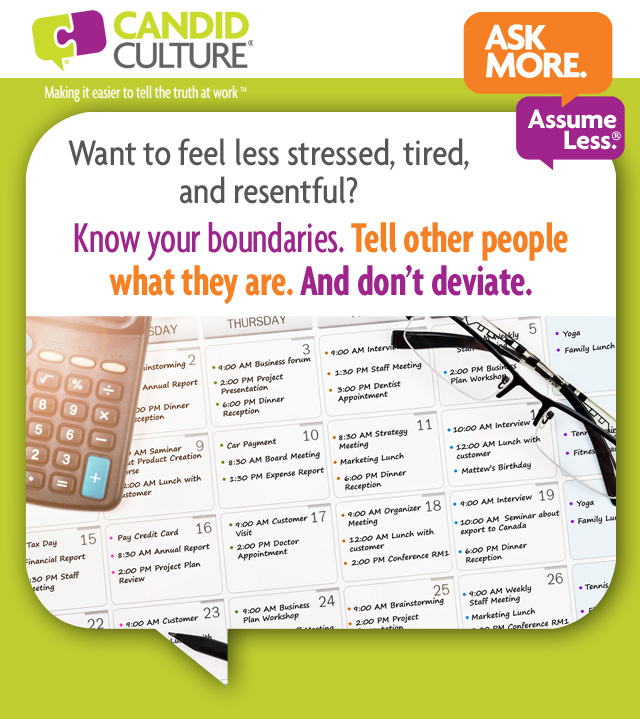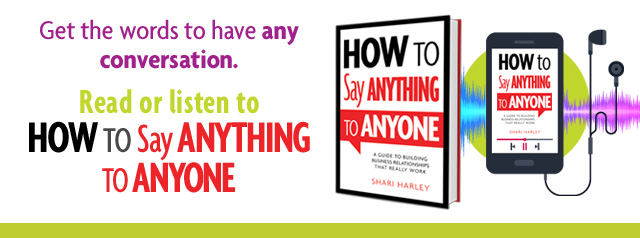Posts Tagged ‘manage stress’
You receive a meeting request for April 5th. Your calendar is open, so you accept the request. You get asked to visit an out-of-state client on April 12th. Your calendar is open, so you say yes. You’re asked to make a presentation in place of a team member who is out of town, on April 14th. You want to be a team player, so you say yes. And soon what was a relatively slow month is booked with meetings, travel, and other commitments. Mid-month you’re tired, over-extended, and resentful. You want to be a good team member and a responsive professional. How do you do both without feeling tired and resentful?
One of the best pieces of advice I heard many years ago was to decide how to handle something before the situation presents itself. For example, if you’re trying to lose weight and you’re going to an event that will have an amazing buffet, decide what you will and won’t eat before you arrive. Choosing not to eat the desserts will be much easier if you’ve made that decision before the event rather than when you’re standing in front of temptation. Managing commitments and schedules can work the same way.
Before having a child, I worked 80 hours a week and traveled up to six days a week. After having my son, I realized that I didn’t want to keep that kind of schedule anymore. I needed to cut back. So, I created clear and specific boundaries for myself. I decided how many days a month I would travel, by what time I needed to arrive home from a trip, and how many speaking engagements I would commit to each month. When I received speaking requests, I honored my pre-established boundaries. If I was already on the road the maximum number of days, I told myself I would travel, I asked if the client could do a different month and if the answer was no, I turned the work down.
I never deviated from my established boundaries. And when speaking requests came in, the decision-making wasn’t a struggle. I didn’t have to decide if accepting a request would be too much. I’d already made the hard decisions about the schedule I would keep. So, each incoming request either fit into my already-decided-schedule or it didn’t.
I work for myself. I have latitude to make decisions about my schedule that I might not if I still had corporate job. So how do you make and share decisions when you’re not your own boss?

Decide what you want your schedule to look like. How many hours do you want to work a week? What time would you like to start and stop working on most days? How much travel are you willing and able to do? How many meetings can you attend a day and still get your work done, so you’re not working each evening or weekend?
Then communicate your desired schedule to the person you work for. Tell your manager how much travel you would like to do and the hours you would like to work. Then negotiate. You may not be able to maintain the schedule you want all the time, but you certainly won’t if you don’t make your desires known.
The time to tell your manager that you want to reduce your travel is before you’re asked to take a trip, not after. But it’s never too late. If you find yourself too busy or on the road too much, you can always have a conversation and renegotiate.
It’s been two years since I’ve traveled for work or done an in-person speaking engagement. I’m just now accepting speaking engagements that will put me back on the road. And I’ve realized that I need to reset my boundaries. Life has changed in the past two years. I need to re-adjust my commitments to myself. And the time to do that is before the next speaking requests comes in, not after.

 The first time my now almost-three-year-old son stood up in his crib, I didn’t see it. I was sitting in his room watching him at the time. I was literally watching him in his crib, and yet I didn’t notice when he stood up for the first time. I wasn’t looking at my phone or talking with someone else. It was just he and I in the room, and yet I was so distracted with whatever I was thinking about, I didn’t ‘see’ him stand up for the first time.
The first time my now almost-three-year-old son stood up in his crib, I didn’t see it. I was sitting in his room watching him at the time. I was literally watching him in his crib, and yet I didn’t notice when he stood up for the first time. I wasn’t looking at my phone or talking with someone else. It was just he and I in the room, and yet I was so distracted with whatever I was thinking about, I didn’t ‘see’ him stand up for the first time.
When he was born, I was given the advice to stay present. And I scoffed at that advice. Of course I would stay present.
Living in the present sounds so simple. When you walk, walk. When you eat, eat. When you work, work. We’ve all heard this advice, and yet, it’s so hard to do.
Before having a baby, I would lie awake in bed at night worrying about the vendor who wasn’t the right fit, a decision I needed to make, or something I needed to finish. Now I think about those things when I’m ‘with’ my son – watching him, but not seeing.
If we’re thinking about anything other than then what we’re doing, we’re not living in the present moment. Instead, we’re focused on either the past or the future. And this is where stress and anxiety live. If we only think about what’s happening now, it’s impossible to be stressed, anxious, or worried. The question is how to stay present when our brains want to do anything but.
Here are seven strategies for living in the present moment:
Live in the present strategy one: Write down everything you need to do, so you can free your brain from thinking about it.
Live in the present strategy two: Don’t over commit or over plan. Plan days with a schedule that you can easily achieve. Over committing causes stress and worry.
Live in the present strategy three: Only commit to do things you really plan (and at least in your personal life, really want) to do.
Live in the present strategy four: Give yourself a limited and prescribed time to talk about a problem and/or to worry about it. When the time is up, let it go and think about something else. Ask the people around you to help hold to this time limit. If you bring the topic up in conversation, ask your colleagues to point out that you’re still focused on the problem and refuse to have the conversation with you.
Live in the present strategy five: Remind yourself (from moment to moment) to be present. When I’m with my son, I remind myself to really be with him and not thinking about or doing something else.
Live in the present strategy six: Compartmentalize your time. Determine how long you’re going to do something, and only do that activity during that time period. When the time is up, move on to something else. When I’m not with clients, I spend half of each workday with my son. And when I’m with him, I don’t have my phone so I’m not tempted to check my email. When I’m with him, I’m really with him.
Live in the present strategy seven: Leave your phone some place you can’t see it. We are addicted to these little people separators. I find that one of the only ways I don’t check my phone, is not to carry the phone with me.
Being in the present moment requires discipline. If you want to feel more peaceful and less stressed, think only about what you’re doing. Let everyone else worry about the rest.


The first time my now eleven-month old son stood up in his crib, I didn’t see it. I was sitting in his room watching him at the time. I was literally watching him in his crib, and yet I didn’t notice when he stood up for the first time. I wasn’t looking at my phone or talking with someone else. It was just he and I in the room, and yet I was so distracted with whatever I was thinking about, I didn’t ‘see’ him stand up for the first time.
When he was born, I was given the advice to stay present. And I scoffed at that advice. Of course I would stay present.
Living in the present sounds so simple. When you walk, walk. When you eat, eat. When you work, work. We’ve all heard this advice, and yet, it’s so hard to do.
Before having a baby, I would lie awake in bed at night worrying about the vendor who wasn’t the right fit, a decision I needed to make, or something I needed to finish. Now I think about those things when I’m ‘with’ my son – watching him, but not seeing.
If we’re thinking about anything other than then what we’re doing, we’re not living in the present moment. Instead, we’re focused on either the past or the future. And this is where stress and anxiety live. If we only think about what’s happening now, it’s impossible to be stressed, anxious, or worried. The question is how to stay present when our brains want to do anything but.
Here are seven strategies for living in the present moment:
Live in the present strategy one: Write down everything you need to do, so you can free your brain from thinking about it.
Live in the present strategy two: Don’t over commit or over plan. Plan days with a schedule that you can easily achieve. Over committing causes stress and worry.
Live in the present strategy three: Only commit to do things you really plan (and at least in your personal life, really want) to do.
Live in the present strategy four: Give yourself a limited and prescribed time to talk about a problem and/or to worry about it. When the time is up, let it go and think about something else. Ask the people around you to help hold to this time limit. If you bring the topic up in conversation, ask your colleagues to point out that you’re still focused on the problem and refuse to have the conversation with you.
Live in the present strategy five: Remind yourself (from moment to moment) to be present. When I’m with my son, I remind myself to really be with him and not thinking about or doing something else.
Live in the present strategy six: Compartmentalize your time. Determine how long you’re going to do something, and only do that activity during that time period. When the time is up, move on to something else. When I’m not with clients, I spend half of each workday with my son. And when I’m with him, I don’t have my phone so I’m not tempted to check my email. When I’m with him, I’m really with him.
Live in the present strategy seven: Leave your phone some place you can’t see it. We are addicted to these little people separators. I find that one of the only ways I don’t check my phone, is not to carry the phone with me.
Being in the present moment requires discipline. If you want to feel more peaceful and less stressed, think only about what you’re doing. Let everyone else worry about the rest.

 It’s hard to come back to work after a long weekend, no matter how much you like your job. As fun and fulfilling as work can be, we all struggle with back to work blues from time to time.
It’s hard to come back to work after a long weekend, no matter how much you like your job. As fun and fulfilling as work can be, we all struggle with back to work blues from time to time.
If you’re having a hard time getting back into it today, here are a few things to try:
- Be realistic about how much you’re going to do today. Move a few things on today’s to-do list to tomorrow, or maybe Wednesday. Setting unrealistic goals sets people up for frustration and feelings of failure.
- Pick one or two things you’re going to do today, and finish those two things.
- Do one thing at a time. Not five.
Stress occurs when we’re thinking about the past or the future. When we’re in the moment, there is nothing to stress about. You’re focused on what you’re doing, nothing else. This is easier said than done, which is why I do yoga. If I’m thinking about anything but the teacher’s instructions, I fall over.
- Plan something fun. When is your next vacation? What are you looking forward to? Having something fun and exciting on the horizon is motivating and keeps us going.
- If you’re not having fun at work or you’re feeling stuck, tell someone who can do something about it. Most people are so afraid of being fired, they don’t speak up at work. From my experience it’s not so easy to get fired. Look around. I suspect there are several people you work with who you think deserve to be fired, yet there they are. Worry less. Speak up more. No organization is going to fire you for wanting and being willing and able to do more.
If after all of these BRILLIANT suggestions you still find yourself in the back to work blues, gossip about a few people who haven’t made it in yet today, eat someone else’s lunch from the refrigerator that looks better than what you brought, and re-arrange the most organized person’s desk. And all will be well.
Advance your career and manage people with our top three sellers.



Posted under
Uncategorized on March 3, 2013 by Shari Harley. Comments
Most of us have heard the ‘motivational’ phrase, “Live every day as if it was your last.” I don’t think that’s a great plan. If I lived every day as if it was my last I’d say things I’d regret and eat so much chocolate, cookies, and ice cream, I’d be the size of a house. I’d prefer to ask this question: “How would I live if this was the best day of my life?”
If every day was going to be the best day of your life, what would you do? Who would you spend time with? What would you give your time and energy to? What would you think about? Our thoughts drive our daily experience more than anything else.
When I’m frustrated and stressed out, which is a regular occurrence, I ask myself, “What if today was the best day of my life?” And that question shifts my thoughts, which alters my experience. It quiets the constant churn in my brain, which has me feel like I’m a hamster on a treadmill of constant problem solving, and at times obsessing about what will and won’t be.
The next time you’re upset or having a bad day, ask yourself, “What if this was the best day of my life? What would I give my time, energy, and attention to?” And if your energy is misplaced, it’s easy to make that change.
The concept of simply choosing to be happy may sound unrealistic and pollyanna, but it’s working for me. When I’m frustrated and can get present enough to make a conscious choice about where to put my thoughts, versus being on auto pilot, I tell myself to choose happiness. And it usually works. Just thinking, “I choose to be happy” gets me out of my regular thoughts, which typically take me nowhere good.
I have first world problems, and for the most part, so do you. The work gets done in time. The relationships work out, as do the finances. All you have is today. Choose happiness.




 The first time my now almost-three-year-old son stood up in his crib, I didn’t see it. I was sitting in his room watching him at the time. I was literally watching him in his crib, and yet I didn’t notice when he stood up for the first time. I wasn’t looking at my phone or talking with someone else. It was just he and I in the room, and yet I was so distracted with whatever I was thinking about, I didn’t ‘see’ him stand up for the first time.
The first time my now almost-three-year-old son stood up in his crib, I didn’t see it. I was sitting in his room watching him at the time. I was literally watching him in his crib, and yet I didn’t notice when he stood up for the first time. I wasn’t looking at my phone or talking with someone else. It was just he and I in the room, and yet I was so distracted with whatever I was thinking about, I didn’t ‘see’ him stand up for the first time.
 It’s hard to come back to work after a long weekend, no matter how much you like your job. As fun and fulfilling as work can be, we all struggle with back to work blues from time to time.
It’s hard to come back to work after a long weekend, no matter how much you like your job. As fun and fulfilling as work can be, we all struggle with back to work blues from time to time.


